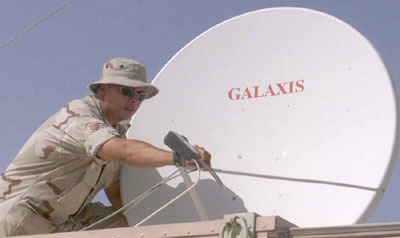Space and other advanced technology and the war in Iraqby Taylor Dinerman
|
| Only by combining technology, including space technology, with human intelligence as well as political warfare, can the war in Iraq be won in a reasonable time period. |
In the Nineties, the Algerian and Egyptian governments were able to more or less eradicate their homegrown Islamic terrorists. The methods they used cannot be replicated by the US nor its allies if we wish to reach the most important strategic goal, which is to install a democracy in Iraq. The slow and methodical process of building up a reasonably honest, competent, and humane Iraqi police force is going to take a long time. In the long term, such a police force will be able to eradicate the terrorist better than any US military force ever will but, in the short term, the US and its allies have got to find ways to bring these enemies under control.
To dismiss technology as a force multiplier in the war against terrorism, as some pundits tend to do, is to throw away America’s strongest available weapon in favor of methods that will take years to properly develop. Only by combining technology, including space technology, with human intelligence as well as political warfare, can the war in Iraq be won in a reasonable time period. Already, the DoD is putting a big effort into adapting its existing systems to the needs of the guys on the ground in Iraq. Creativity, rather than big budgets, is what is now needed.
For example, archeologists have developed methods using satellite remote sensing data to find ancient trade routes that once crisscrossed the desert. There is no reason that the DoD cannot use these same methods to detect smuggling routes used by terrorists to infiltrate Iraq.
The GPS and weather satellites need not only to be kept at peak operating effectiveness, but their operators need to be constantly thinking of innovative ways to use them to support operations in Iraq and Afghanistan. Weather forecasters should concentrate on determining what weather condition degrade the heat seeking systems on the SA-7 and the other shoulder fired missiles used against our aircraft. The GPS units inside Air Force Space Command should be thinking about how to improve the speed with which target coordinates are transmitted from a mortar detecting radar to an Apache helicopter or other “shooter.”
Other new ideas include finding ways to use high-powered microwaves to disable the detonators on roadside bombs, or new sensors that can detect explosives. There is a lot of interesting technology, both inside the Pentagon and in the civilian marketplace. Finding ways to get it into the hands of the troops on the ground as soon as possible is the biggest challenge. Procurement regulations are designed to insure that no one ever cheats the government. These regulations now insure that no soldier will ever get what he or she needs until long after they are dead, wounded or discharged.
| Archeologists have developed methods using satellite remote sensing data to find ancient trade routes that once crisscrossed the desert. There same methods can be used to detect smuggling routes used by terrorists to infiltrate Iraq. |
It took more than 10 years to move the Bradley Fighting Vehicle from the concept stage to units in the field. Other systems have taken even longer. Rumsfeld has been trying to change the way the Department does business. Some concepts, such as the Advanced Technology Concept Demonstration projects, are changing the way things happen, but now speed is by far the most important thing.
Some new technology is flowing into Iraq. A flood of new technology could overwhelm the enemy. They may be able to adapt to one or two new systems every month—there is no way they could confront one or two dozen new weapons and sensors. Some of the new systems will probably not work as planned. This should be expected and should not discourage the military from continuously trying new things.
The goal should be to create more new problems for them every day, than they create for us. Whether we do it with technology or tactics may not matter. The aim should be to eradicate their ability to use the OODA cycle. We must constantly be thinking about how can we change the situation faster than they can adapt.
